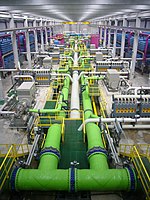
Photo from wikipedia
Antimony (Sb) traces in water pose a serious threat to human health due to their negative effects. In this work, nanoscale zero-valent iron (Fe0) supported on activated carbon (nZVI) was… Click to show full abstract
Antimony (Sb) traces in water pose a serious threat to human health due to their negative effects. In this work, nanoscale zero-valent iron (Fe0) supported on activated carbon (nZVI) was employed for eliminating Sb(V) from the drinking water. To better understand the overall process, the effects of several experimental variables, including pH, dissolved oxygen (DO), coexisting ions, and adsorption kinetics on the removal of Sb(V) from the SW were investigated by employing fixed-bed column runs or batch-adsorption methods. A pH of 4.5 and 72 h of equilibrium time were found to be the ideal conditions for drinking water. The presence of phosphate (PO43−), silicate (SiO42−), chromate (CrO42−) and arsenate (AsO43−) significantly decreased the rate of Sb(V) removal, while humic acid and other anions exhibited a negligible effect. The capacity for Sb(V) uptake decreased from 6.665 to 2.433 mg when the flow rate was increased from 5 to 10 mL·min−1. The dynamic adsorption penetration curves of Sb(V) were 116.4% and 144.1% with the weak magnetic field (WMF) in fixed-bed column runs. Considering the removal rate of Sb(V), reusability, operability, no release of Sb(V) after being incorporated into the iron (hydr)oxides structure, it can be concluded that WMF coupled with ZVI would be an effective Sb(V) immobilization technology for drinking water.
Journal Title: Toxics
Year Published: 2021
Link to full text (if available)
Share on Social Media: Sign Up to like & get
recommendations!